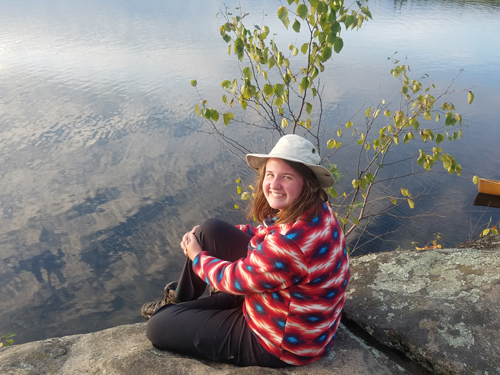Cycles of life: razed to rebirth

By Darren Bush
“In nature, nothing is perfect and everything is perfect. Trees can be contorted, bent in weird ways, and they’re still beautiful.” – Alice Walker
In 2006 and 2007, two wildfires raged through the Boundary Waters Canoe Area (BWCA), burning over 100,000 acres. What was left looked apocalyptic. Burned tree trunks stood as silent sentinels over blackened rock and soil.
A 64-year-old man was convicted of setting the Ham Lake fire through his carelessness, and for lying to Forest Service authorities, but that’s not really relevant here. What is important is that a large chunk of a beautiful area is not what it once was.
Last month I took a group of friends to visit the BWCA, our route taking us through a good chunk of the burned-over area. My reasons were simple.
First, I like solitude. The burned-over area isn’t as popular, so we saw two other canoes in six days on the water, so that mission was accomplished.
Second, I wanted to see what a decade can do to repair the damage. Century-old pines are gorgeous, and we’d see some of them, of course, but a large portion of our route was through an area ravaged by fire.

Ellie had never been to the Boundary Waters. Still, it was a place that was dear to her heart.
At Ellie’s grandfather’s funeral a few months ago, on the table of memorabilia, I saw a picture of her grandfather in a hammock, strung between two trees in the Boundary Waters. After the funeral while we were drying tears and exchanging embraces, I asked Ellie if she would like to go with us on the canoe trip.
At sixteen, she would miss a week of school. Her mother was wise enough to not let school get in the way of her education. I salute you, Mom. You get it.
A month later we found ourselves and our gear crammed into two vehicles, driving up Highway 61 on the north shore of Superior on the way to Grand Marais, one of my favorite places in the world. We stopped at our lodging and dumped everything on the floor of the cabin and started sorting. We weeded out a little more gear and some extra food we wouldn’t need and repacked, ready for the morning.
——
The Tuscarora portage is one of the longer portages in the BWCA. It’s well over a mile, and unless you’re taking everything in one load, you get to walk it three times. The destination is well worth the effort. Unaffected by the burn, Tuscarora is a lovely lake with islands and many campsites. We pushed forward across the lake as the wind began to blow in earnest.
We eddied out behind a little outcropping and dragged out the gorp. My wife Stephanie made twenty pounds of gorp before the trip for times just as this; we needed water, and we needed M&Ms with a few peanuts added for good measure. We watched the wind, ate Gail’s delicious bourbon barbecue jerky, and waited. We waited in vain.
——

Ellie couldn’t stop smiling. Every time I looked in her direction, she was smiling. She smiled carrying a 60-pound pack over muddy, rocky, root-strewn portages. She smiled carrying a canoe with a very uncomfortable yoke up a granite slab, dodging seedlings that had established themselves in cracks and crevasses. She smiled eating quesadillas that were prepared over a campfire on a U.S. Forest Service cast iron grate, but then again we all smiled at that one.
Our first campsite had two beautiful trees about ten feet apart, and the hammock came out immediately.
——
The little red dots indicate campsites. My maps were pre-burn, so searching for a campsite was an exercise in probability. Many were there, but the ones in heavily burned-over areas were abandoned. No one wants a latrine in the middle of a copse of charred trunks. Black trunks still stood tall, surrounded by ten-foot pines that were aerial seeded after the fire, and it was easy to see where the fire grate used to be.
The good sites were still wooded, but many had a stark view of a less than verdant landscape. Ellie was in love with her surroundings, and had little to criticize about the burn. I paddled through that area 13 years ago and it was lovely, and to me, it was a little sad. To Ellie there was nothing sad about the landscape. To her it was all beautiful.
That’s because it was beautiful.
Nineteenth century naturalist John Burroughs said that he went to nature “… to be soothed and healed, to have [his] senses put in order.” I believe Ellie’s grandfather believed this, and Ellie wanted to experience this after her loss.
Watching Ellie swaying gently in her hammock, overlooking the lake like her grandfather thirty years ago, soothed and healed me as much as it healed her. Burn or no burn, the scene put my senses in order.





